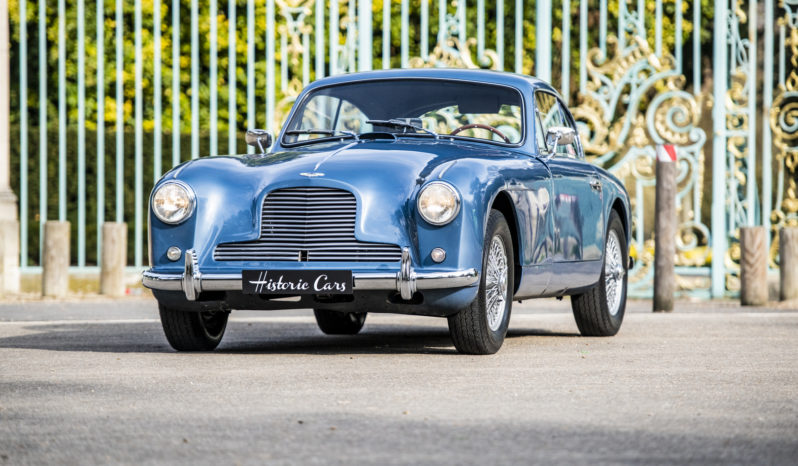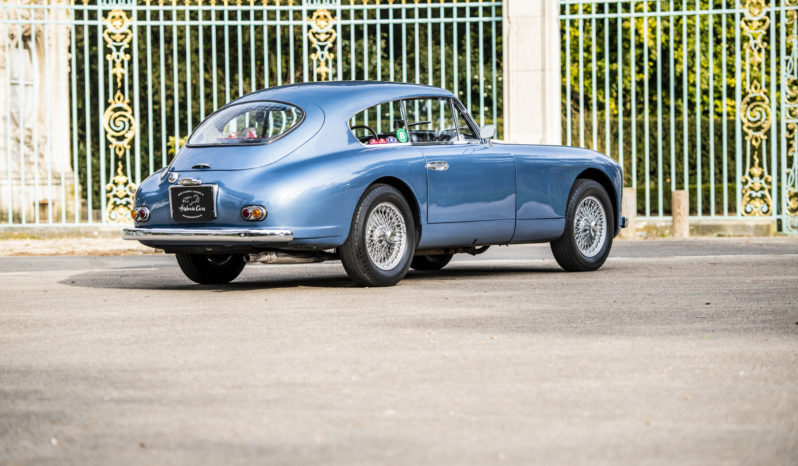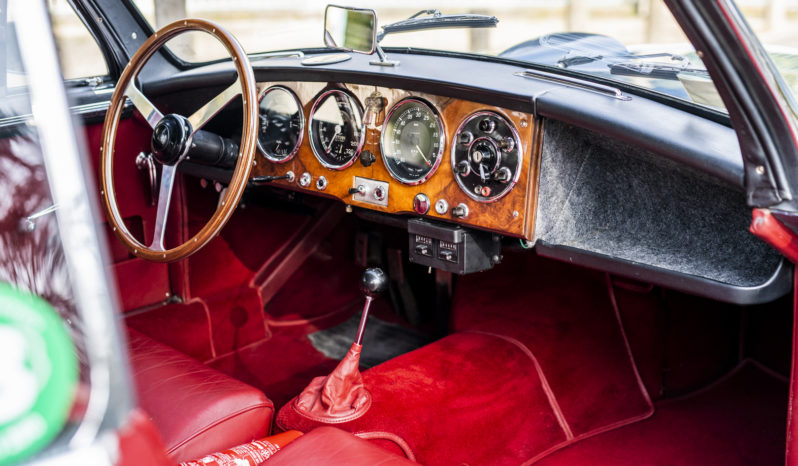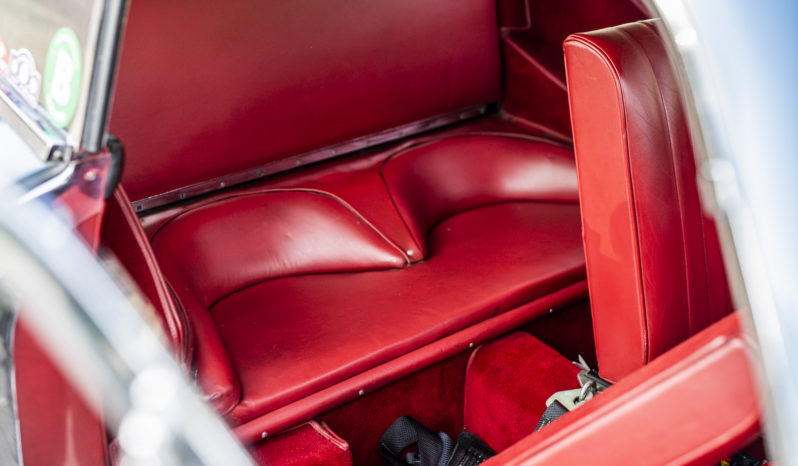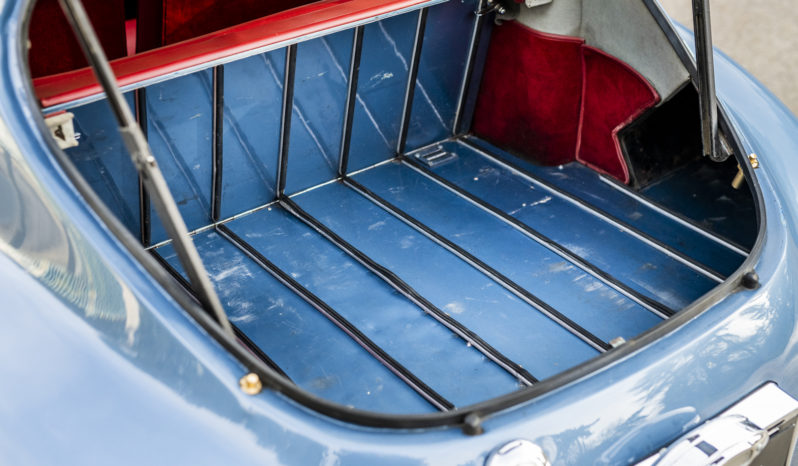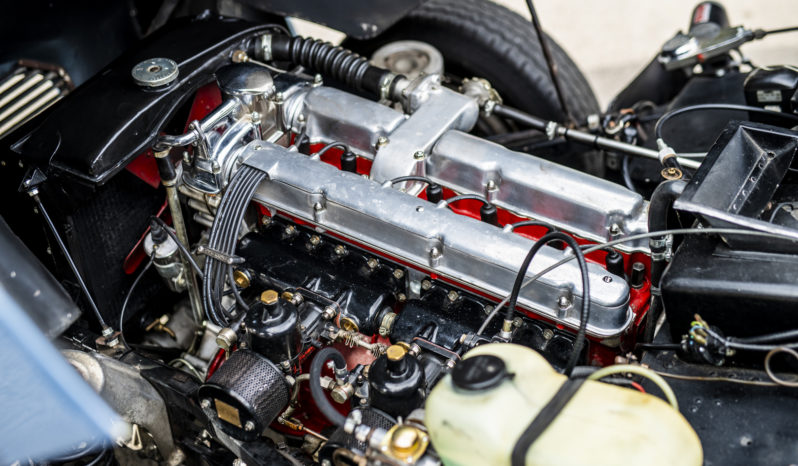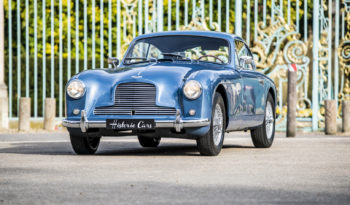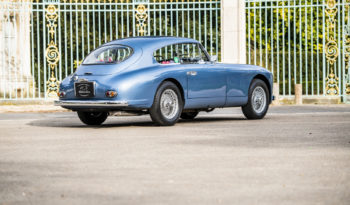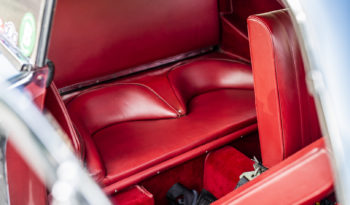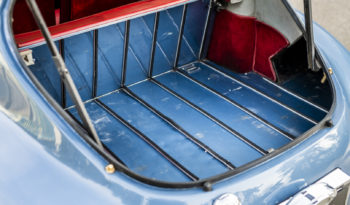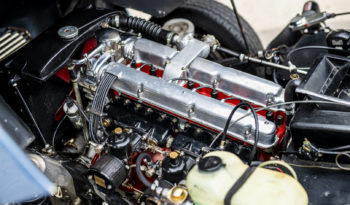Aston Martin DB2/4
LE REGNE DES DB
A la fin de la seconde guerre mondiale, bon nombre de constructeurs automobiles
sont en graves difficultés financières. La survie d’Aston Martin tient du miracle et à
l’engouement particulier d’un riche industriel anglais, fabricant de tracteurs de son état,
David Brown. Il rachète la société en 1947 et dès 1948, remet l’entreprise sur les chemins
de la gloire avec une victoire inespérée aux 24H de Spa. Une nouvelle ère s’ouvre alors pour Aston Martin, sous le règne des D.B…
Martin, comme Lionel Martin, qui créa son entreprise en 1922, et Aston, en référence à la course d’Aston-Hilton qu’il remporta en 1913. C’est dire si les origines de la marque ont toujours été liées à la course automobile. Aujourd’hui, on parle volontiers d’Aston, comme un raccourci, mais aussi comme pour se souvenir que son créateur ne resta pas longtemps attaché à son aventure automobile. A travers le prototype Atom mis au point en 1939, Claude Hill invente une structure tubulaire de type châssis-coque (ancêtre du space-frame) avec une suspension à bras oscillant et ressorts hélicoïdaux à l’avant et essieu rigide avec ressorts hélicoïdaux à l’arrière. Mise de côté pendant la guerre, la voiture renaît sous le nom de “2 litres sport” avec une carrosserie remaniée. Ce modèle deviendra plus tard la toute première “DB” de l’histoire et fréquemment appellée DB1. Peu après le rachat de la société Lagonda par Brown, W.O. Bentley, ex-fondateur de Bentley embauché par Aston Martin en 1931, prend une retraite bien méritée, après avoir dirigé la mise au point du modèle qui signera le grand retour d’Aston Martin au premier plan : la DB2.
DB2
La DB2 est d’une ligne beaucoup plus moderne que ne l’était la DB1. Tout d’abord, le cabriolet est abandonné au profit d’une forme fermée de coupé comme sur le prototype DB Mark II engagé au Mans. Ce coupé profilé avec son arrière fast-back marque son arrivée par une participation en force aux 24H du mans 1949. 6 voitures sont sur la ligne de départ, dont 3 par l’usine elle-même. Sa carrosserie en aluminium dont le desin est dû à Frank Feeley s’inspire des meilleures réalisations de Farina du moment. D’ailleurs, elle a été conçue en relation avec Touring à Milan puis construite par Mulliner. Après avoir produit 49 exemplaires, on remarque une nouvelle calandre calandre en forme de T inversé, formée d’une seule ouverture comme sur les DB3-S de 1954, au lieu des 3 éléments chromés de la DB1, et qui restera la signature officielle des Aston aujourd’hui encore. Par rapport à ses rivales de l’époque, Ferrari 212, Jaguar XK, Bristol 401, l’Aston Martin n’a pas à rougir et son prix élevé reflète les ambitions de la marque. L’accueil qui lui est réservé à sa présentation officielle en avril 1950 est exceptionnel et de toute évidence, la grande similitude de la voiture avec celle engagée au Mans n’y est pas étrangère. L’Aston Martin DB2 hérite directement du châssis créé pour l’Atom. La carrosserie est fixée sur un châssis composé d’une structure de tubes à section rectangulaire. A noter que la DB2 est aussi disponible en cabriolet (ou Drop Head Coupe), qui va représenter un quart des ventes totales du modèle. Le freinage à quatre gros tambours et les roues de 16″ à rayons sont les attributs d’une voiture de son temps. La qualité de fabrication est également remarquable. Sellerie cuir Conolly, tableau de bord en bois, chromes délicatement apposés. Déjà chez Aston Martin sport rime avec élégance. La nouvelle Aston DB2 inaugure une évolution du moteur élaboré chez Lagonda (appartenant aussi à Brown) par l’ingénieur Willie Wilson sous la supervision de W.O.Bentley. Le 6 cylindres en ligne 2.6 litres à double arbre à cames en tête fournit 105 ch à 5000 tr/mn et un couple de 180 Nm dès 2750 tr/mn. Une puissance qui permet des performances déjà remarquables à ce coupé pesant tout juste plus de 1100 Kg. Selon le rapport de pont choisi, la belle anglaise accélère de 0 à 96 km/h en 11″2 et file à 190 Km/h. Pour les besoins de la course sarthoise, la puissance du 6 cylindres 2.6L avait été dopée à 123 ch par une culasse modifiée et des carburateurs plus gros. Dès le mois de janvier 1951, une version spéciale de la DB2 dénommée Vantage fut ajoutée à la gamme. Avec les 123 chevaux de la voiture de course elle attire l’attention de nombreux clients qui perçoivent tout son potentiel sur circuit ou en rallye.
DB2/4
A cette époque, la concurrence entre constructeurs de voitures de sport devient plus intense que jamais. D’année en année, le niveau de performances est relevé ! A tel point que rapidement, la firme installée à Feltham doit optimiser son modèle. Par ailleurs, David Brown pense qu’une sportive qui ménage des aspects pratiques doit pouvoir trouver une clientèle plus large. Une version améliorée de la DB2 baptisée DB2/4 arrive au salon de Londres en 1953, bénéficiant de nombreuses améliorations. Extérieurement, elle se distingue par un positionnement de phares plus haut et le renvoi des clignotant en-dessous. L’empattement est allongé de 18 cm et la ligne du pavillon est également retouchée pour permettre d’offrir 2 places supplémentaires, dont le dossier est rabattable. La DB2 devient alors une 2+2 (ou 2/4 seater en anglais) et, même si ces places n’ont absolument rien de spacieuses, l’auto est appellée “family saloon” dans les brochures commerciales. Le nouveau hayon arrière facilite l’accès aux bagages et le volume de chargement, se montrant alors très novateur face aux coupés de sport classiques. A noter quelques rarissimes réalisations signées Bertone (3 spiders, 1 berlinetta) ou Allemano, au design bien différent. La motorisation n’est pas nouvelle en revanche, hormis une puissance portée à 125 ch en standard, ce qui compense à peine le poids supérieur. Mais dès 1954 le 6 cylindres gagne en volume et atteint désormais 2922 cm3 par augmentation de l’alésage (83 mm) pour une puissance de 142 ch. La DB2/4 décroche la barre symbolique des 200 Km/h et se positionne ainsi parmi les meilleures sportives du moment. Dans une Europe de vitesse libre, l’Aston Martin séduit des millionnaires prêt à dépenser 3 millions et demi de francs (en 1955) pour s’offrir ce bijou. Un effort financier récompensé dès la mise en route du 6 cylindres, dont la sonorité rauque et métallique anime la conduite. Par ailleurs, bien que fermement suspendue, la DB2 se revèle être une GT avant l’heure, douce et fiable autant qu’amusante à conduire.
DB2/4 MK II & MK III
A partir de 1955, la DB2/4 est assemblée chez Tickford à Newport Pagnell. Une version éphémère baptisée “Fixed Head Coupé” fait une apparition contestée par sa ligne, et dès 1958 Aston l’abandonne la MK III la remplace à son tour. Cette version fut la dernière évolution sur base du châssis Atom avec le moteur dessinné par W.O. Bentley. En 1958, l’entreprise déménage dans l’usine de Tickford qui est intégrée au groupe et en octobre, David brown présente la remplaçante des DB2, la DB4, qui marque l’arrêt définitif du modèle en juillet 1959.
PRODUCTION ASTON MARTIN DB2
DB2 : 309 coupés, 100 cabriolets
DB2/4 MKI : 492 coupés, 73 cabriolets
DB2/4 MKII : 141 coupés, 24 cabriolets, 34 Fixed head coupés
DB2/4 MKIII : 551 exemplaires
CONCLUSION
Produite pendant 9 ans, l’Aston Martin DB2 est la concrétisation de la passion de David Brown pour les voitures de sport de grande qualité. La DB2 restera donc comme l’ambassadrice du grand retour de la firme au plan international, qui après avoir frôlé la faillite au lendemain de la guerre va poursuivre son ascension vers les sommets de la catégorie naissante des “Grand Tourisme”. Pour les fanatiques de la marque, elle reste la meilleure lignée des Aston, celle qui privilégiait le plus le sport au confort.
Livrée neuve par l’importateur Aston Martin en France Mirabeau Garage à M PAGAZY qui demeurant 250 rue de Rivoli le 06-01-1955. Notre Aston Martin arbore une élégante robe grise associée a un intérieur Rouge et une immatriculation : 1250 DM 75. Nous retrouvons la voiture ensuite au nom de Levesque puis Hue, avant que l’actuel propriétaire s’en porte acquéreur il y a 20 ans en 2003 alors que l’auto est alors propriété de Patrick Peter depuis 1999. Toujours équipée de son Bloc Moteur 3L (VB6J) d’origine, elle fut très bien entretenue en mécanique lors de ces presque 20 ans. On note par exemple la réfection du moteur en 2006 puis á nouveau en 2012 chez Dorset, l’installation d’une direction assistée en 2014 et a nouveau une importante révision moteur en 2018-19. A noter que l’auto a toujours été utilisée régulièrement lors de grands rallyes comme le Tour Auto, les rallyes de l’Automobile Club de France, coupes des Alpes et autres Rallye de Paris.
Prêtes a rouler, elle n’attend que son nouveau propriétaire pour sillonner à nouveau les routes d’Europe.
THE REIGN OF THE DB
At the end of the Second World War, many car manufacturers were in serious financial difficulties. Aston Martin’s survival was a miracle, thanks to the enthusiasm of a wealthy English industrialist and tractor manufacturer, David Brown. He bought the company in 1947 and in 1948 put the company back on the road to glory with an unexpected victory in the 24 Hours of Spa. A new era began for Aston Martin, under the reign of the D.B…
Martin, as in Lionel Martin, who created his company in 1922, and Aston, in reference to the Aston-Hilton race he won in 1913. This shows that the origins of the brand have always been linked to motor racing. Today, we like to talk about Aston, as a shortcut, but also as a reminder that its creator did not remain attached to his automobile adventure for long. With the Atom prototype developed in 1939, Claude Hill invented a tubular structure of the chassis-shell type (ancestor of the space-frame) with a swing arm suspension and coil springs at the front and a rigid axle with coil springs at the rear. Put aside during the war, the car was reborn as a “2-liter sport” with a redesigned body. This model would later become the very first “DB” in history and frequently referred to as the DB1. Shortly after Brown bought the Lagonda company, W.O. Bentley, former Bentley founder hired by Aston Martin in 1931, took a well-deserved retirement, after having directed the development of the model that would sign Aston Martin’s great return to the forefront: the DB2.
DB2
The DB2 is much more modern in design than the DB1. First of all, the convertible is abandoned in favor of a closed coupe shape like the DB Mark II prototype entered at Le Mans. This streamlined coupe with its fastback rear end marks its arrival with a strong participation in the 24H du Mans 1949. 6 cars are on the starting line, including 3 by the factory itself. Its aluminium bodywork, designed by Frank Feeley, was inspired by the best Farina creations of the time. Moreover, it was designed in relation with Touring in Milan then built by Mulliner. After having produced 49 examples, one notices a new grille in the shape of inverted T, formed of only one opening as on the DB3-S of 1954, instead of the 3 chromed elements of the DB1, and which will remain the official signature of Aston even today. Compared to its rivals of the time, Ferrari 212, Jaguar XK, Bristol 401, the Aston Martin has nothing to be ashamed of and its high price reflects the ambitions of the brand. The warm welcome it received at its official presentation in April 1950 was exceptional, and obviously the car’s great similarity to the one entered at Le Mans was no stranger to this. The Aston Martin DB2 directly inherits the chassis created for the Atom. The body is fixed on a chassis made of a rectangular tube structure. Note that the DB2 is also available as a convertible (or Drop Head Coupe), which will account for a quarter of total sales of the model. The four large drums brakes and the 16″ wheels with spokes are the attributes of a car of its time. The build quality is also remarkable. Conolly leather upholstery, wooden dashboard, delicately applied chrome. Already at Aston Martin sport rhymes with elegance. The new Aston DB2 inaugurates an evolution of the engine developed at Lagonda (also owned by Brown) by engineer Willie Wilson under the supervision of W.O.Bentley. The 2.6-liter in-line 6-cylinder engine with double overhead camshafts delivers 105 hp at 5,000 rpm and 180 Nm of torque from 2,750 rpm. A power that allows already remarkable performances to this coupe weighing just over 1100 Kg. Depending on the gear ratio chosen, the beautiful English car accelerates from 0 to 96 km/h in 11.2 seconds and runs at 190 km/h. For the needs of the Sarthe race, the power of the 6-cylinder 2.6L was boosted to 123 hp by a modified cylinder head and larger carburetors. In January 1951, a special version of the DB2 called Vantage was added to the range. With the 123 horsepower of the race car, it attracted the attention of many customers who saw its potential on the racetrack or in rallies.
DB2/4
At that time, the competition between sports car manufacturers became more intense than ever. Year after year, the level of performance is raised! So much so that the Feltham-based company had to optimize its model. Moreover, David Brown thinks that a sports car that has practical aspects should be able to find a wider clientele. An improved version of the DB2, called DB2/4, arrived at the London Motor Show in 1953 with many improvements. Externally, the headlights were positioned higher, and the turn signals were moved to the bottom. The wheelbase was lengthened by 18 cm and the roofline was also redesigned to offer 2 additional seats, with folding backrests. The DB2 becomes a 2+2 (or 2/4 seater in English) and, even if these seats are not spacious at all, the car is called “family saloon” in the commercial brochures. The new rear hatch facilitates the access to luggage and the loading volume, thus showing itself to be very innovative compared to the classic sports coupes. There are a few rare creations signed Bertone (3 spiders, 1 berlinetta) or Allemano, with a very different design. The engine, on the other hand, is not new, except for a power increased to 125 hp as standard, which barely compensates for the higher weight. But from 1954 the 6-cylinder engine gains in volume and reaches now 2922 cm3 by increasing the bore (83 mm) for a power of 142 hp. The DB2/4 reaches the symbolic 200 km/h mark and is thus positioned among the best sports cars of the moment. In a Europe of free speed, the Aston Martin seduces wealthy gentlemen ready to spend 3 and a half million francs (in 1955) to buy this jewel. A financial effort that was rewarded as soon as the 6-cylinder engine was started up, with its raucous, metallic sound that enlivened the driving experience. Moreover, although firmly suspended, the DB2 proves to be a GT before its time, smooth and reliable as well as fun to drive.
DB2/4 MK II & MK III
From 1955, the DB2/4 is assembled at Tickford in Newport Pagnell. A short-lived version called “Fixed Head Coupé” made an appearance that was contested by its line, and in 1958 Aston abandoned it and the MK III replaced it. This version was the last evolution based on the Atom chassis with the engine designed by W.O. Bentley. In 1958, the company moves to the Tickford factory which is integrated into the group and in October, David Brown presents the replacement of the DB2, the DB4, which marks the final stop of the model in July 1959.
PRODUCTION ASTON MARTIN DB2
DB2: 309 coupés, 100 cabriolets
DB2/4 MKI : 492 coupés, 73 cabriolets
DB2/4 MKII : 141 coupés, 24 cabriolets, 34 fixed head coupés
DB2/4 MKIII : 551 units
CONCLUSION
Produced for 9 years, the Aston Martin DB2 is the concretization of David Brown’s passion for high quality sports cars. The DB2 will remain as the ambassador of the great return of the firm to the international level, which after having been close to bankruptcy after the war will continue its ascent to the top of the emerging category of “Grand Tourism”. For the fanatics of the brand, it remains the best lineage of Aston, the one which privileged the sport to the comfort.
Delivered new by the Aston Martin importer in France Mirabeau Garage to M PAGAZY who lived 250 rue de Rivoli on 06-01-1955. Our Aston is produced in a seducing Grey color with a Red interior its first registration is 1250 DM 75. The car is then registered to Levesque and then Hue, before the current owner bought it 20 years ago in 2003, when it was owned by Patrick Peter since 1999. Still equipped with its original 3L engine block (VB6J), it has been very well maintained mechanically during its almost 20 years. The car has had an engine rebuilt in 2006 and again in 2012 at Dorset, a power steering system installed in 2014, and an engine overhaul in 2018-19. The car has always been used regularly in major rallies such as the Tour Auto, the Automobile Club de France rallies, the Coupe des Alpes and the Rallye de Paris.
Ready to be driven, it is only waiting for its new owner to drive it on the roads of Europe again.




 Français
Français